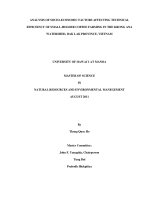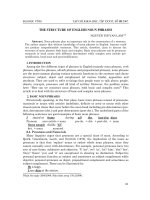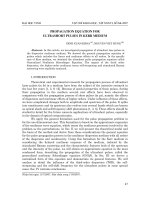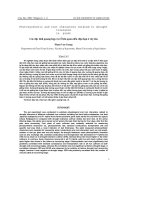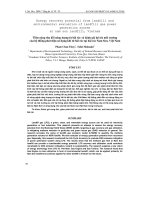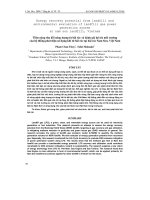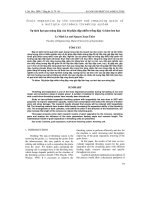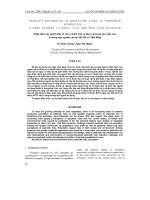Scientific report: "The factors affecting the productivity of fabric and fabric channel selection consumption of fresh produce cloth in Thanh Ha district, Hai Duong Province, Vietnam" pptx
Bạn đang xem bản rút gọn của tài liệu. Xem và tải ngay bản đầy đủ của tài liệu tại đây (242.82 KB, 7 trang )
J. Sci. Dev. 2009, 7 (Eng.Iss.1): 123 - 129 HA NOI UNIVERSITY OF AGRICULTURE
123
Factors affecting lychee productivity and the choices
of
fresh lychee marketing channels of producers in Thanh
ha district, Hai duong province, Vietnam
Các yếu tố ảnh hưởng đến năng suất vải và sự lựa chọn kênh tiêu thụ vải tươi
của người sản xuất vải ở huyện Thanh Hà, tỉnh Hải Dương, Việt Nam
Nguyen Anh Tru
Faculty of Accounting and Business Management
TÓM TẮT
Vải là một sản phẩm có giá trị cao, được trồng ở nhiều địa phương khác nhau ở Việt Nam như
Hải Dương, Bắc Giang, Quảng Ninh, Lạng Sơn, v.v… Ở Việt Nam, vải được trồng đầu tiên ở huyện
Thanh Hà, tỉnh Hải Dương. Tuy nhiên, trong những năm gần đây thu nhập của người trồng vải có xu
hướng giảm do ảnh hưởng của điều kiện thời tiết, sự tăng giá vật tư đầu vào (phân bón, thuốc bảo vệ
thực vật, v.v…) và sự giảm giá của sản phẩm vải. Mặt khác, người sản xuất phải đối mặt với nhiều
khó khăn trong sản xuất, thu hoạch và tiêu thụ vải tươi. Nghiên cứu này được thực hiện nhằm xác
định và đánh giá ảnh hưởng của các yếu tố đến năng suất vải và lựa chọn các kênh tiêu thụ vải tươi
của người sản xuất vải ở huyện Thanh Hà, tỉnh Hải Dương. Các phương pháp nghiên cứu bao gồm
lựa chọn địa điểm nghiên cứu, chọn mẫu và phân tích mô hình kinh tế lượng. Trong phương pháp
kinh tế lượng, hàm sản xuất Cobb-Douglas và mô hình logit đã được sử dụng để đánh giá ảnh hưởng
của các yếu tố đến năng suất vải và lựa chọn kênh tiêu thụ vải tươi của người sản xuất vải ở huyện
Thanh Hà, tỉnh Hải Dương.
Từ khóa: Kênh tiêu thụ, logit, lựa chọn, năng suất, vải tươi.
SUMMARY
Lychee is a high value commodity. Lychee is planted in the different provinces in Vietnam such
as Haiduong, Bacgiang, Quangninh, Langson, etc. Thanhha district in Haiduong province is
considered as one of the original production areas of lychee in Vietnam. However, benefits of lychee
production in Thanhha district, Haiduong province tended to be declined in recent years because of
climate, increasing in input prices (fertilizer, chemical, pesticides, etc.) and decreasing in lychee
prices. Lychee producers had to face therefore several challenges in production, postharvest and
marketing of fresh lychee. The study was designed to identify and estimate the effects of factors on
lychee production and the choices of fresh lychee marketing channels of producers in Thanhha
district, Haiduong province. Research methodologies are used in the study consisted of selection of
the study area, sampling design and econometric analysis. In terms of econometric analysis, the
Cobb-Douglas production function and the binary logit model are used to evaluate the effects of
factors on the lychee productivity and the choices of fresh lychee marketing channels of producers in
Thanhha district, Haiduong province.
Key words: Choices, fresh lychee, logit, marketing channels, productivity.
Factors affecting lychee productivity and the choices of fresh lychee marketing
124
1. INTRODUCTION
Lychee is a high value commodity. Hence,
commercial lychee growing has advantages to
improve the farmer’s income. The profit generated
in producing lychee is estimated to be five times
more than that by rice production (Vandeveer,
2000).
With 14,000 hectares of planted area and
production of 21,813 tons, Haiduong becomes the
second largest lychee producing province after
Bacgiang province. Additionally, Haiduong is
known as an origin of important varieties of lychee
in Vietnam such as Thieu, Thieu Thanhha and Lai
Thanhha. After the economic transformation in the
country, production and marketing of fresh lychee
have changed. In Thanhha district (Haiduong
province), there are various stakeholders who
participate in production, processing, marketing
and distribution of fresh lychee. These included
growers, collectors, processors, wholesalers,
retailers and consumers.
The study mentioned factors affecting lychee
productivity, included producers’ experience, and
number of family labor, capital, planted area,
manure, fertilizers, pesticides, density, gender and
participation in the lychee association. In the other
word, several factors that affect the choices of fresh
lychee marketing channels of producers in Thanhha
district, Haiduong province, included producers’
experiences in lychee growing, number of family
labor, volume of lychee, selling prices, distance to
markets, gender of producers and participation in
the lychee association.
In this study, influences of these factors are
estimated through applying the binary logit model.
Research objectives
Estimate the factors that affect the lychee
productivity in Thanhha district, Haiduong
province;
Estimate the effects of factors on the
choices of fresh lychee marketing
channels of producers in Thanhha district,
Haiduong province.
2. METHODS
2.1. Selection of the study area
The study covered Thanhha district (Haiduong
province) due to the following reasons: 1) Thanhha
district is known as an origin of lychee tree in
Vietnam; 2) the quality of lychee in Thanhha
district is greater than that in other locations; 3)
lychee planted area (5,600 hectares) and
productivity (15,000 tons/year) in Thanhha are
ranked as the second largest lychee production zone
behind Chilinh district (Haiduong province); and 4)
lychee distribution and marketing in Thanhha
district has to face several challenges.
2.2. Sampling design
According to Salvatore and Reagle (2002), a
random sample size (n) is satisfied if it is at least equal
to 5% of the population size (N) and the number of
observations is at least equal to 30 (n ≥ 30).
There are 25 communes (N = 25) in Thanhha
district. Lychee is cultivated in all of communes in
Thanhha. However, Thanhha is divided into three
lychee cultivated zones consisting of zone 1 (5
communes), zone 2 (16 communes), and zone 3 (4
communes). Therefore, the study included only
three communes in each zone (n = 3). Three
communes (Thanhson, Thanhbinh and Viethong)
were selected because: (1) farmers in these
communes have more experiences in lychee
cultivation compared to other locations; (2) these
communes have the largest lychee planted area and
highest lychee productivity in Thanhha district; (3)
lychee markets are quite active in these communes;
and (4) lychee planted area of each commune is
over 60% of total agricultural area.
According to the Chairman of three communes
(Thanhson, Thanhbinh and Viethong), there are 880
lychee farms in Thanhson, 763 lychee farms in
Thanhbinh and 679 lychee farms in Viethong.
Based on population above, the sample
respondents given the criteria (n = 5%N; n ≥ 30)
were selected: Thanhson commune (44 farmers);
Thanhbinh commune (39 farmers); and Viethong
commune (34 farmers). Lychee farmers were
chosen randomly from the lists of farmers provided
by heads of villages. Therefore, a total of 117
farmers were interviewed in the study (Figure 1).
2.3. Econometric analysis
2.3.1. The Cobb-Douglas production function
The Cobb-Douglas production function is used
to assess the impacts of determinants (explanatory
variables) such as producers’ experience, number
of family labor, capital, planted area, manure,
fertilizers, pesticides, density, gender and
participation in the lychee association on the lychee
productivity (dependent variable).
Nguyen Anh Tru
125
Figure 1. Number of lychee farmers interviewed in Thanhha district, Haiduong province, Vietnam
The Cobb-Douglas production function form:
Y = A.X
1
α1
X
2
α2
X
3
α3
X
4
α4
X
5
α5
X
6
α6
X
7
α7
X
8
α8
e
β1.D1
+ β2.D2 +Ui
(1)
Where:
Y: lychee productivity (kg/sao)
A: the intercept that reveals combined impact of
these fixed factors on lychee productivity
X
1
: producers’ experience in lychee growing
(years)
X
2
: family labor (person)
X
3
: started capital of farmers when growing
lychee (VND 1,000)
X
4
: planted area of lychee (sao)
X
5
: manure (kg/sao/year)
X
6
: fertilizers (kg/sao/year)
X
7
: pesticides (VND 1,000/sao/year)
X
8
: tree density (tree/sao)
D
1
: gender dummy variable (male = 1; female = 0)
D
2
: participation in the lychee association
dummy variable (member = 1; non-member = 0)
(α
1
,…, α
8
): coefficients of explanatory
variables (X
1
,…, X
8
)
β
1
: coefficient of gender dummy variable
β
2
: coefficient of participation in the lychee
association dummy variable
e: natural lagarithms (e = 2.718)
Ui: error term.
Based on equation (1), we can transform the
Cobb-Douglas function to logarithm form:
LnY = LnA + α
1
lnX
1
+ α
2
lnX
2
+ α
3
lnX
3
+ α
4
lnX
4
+ α
5
lnX
5
+ α
6
lnX
6
+ α
7
lnX
7
+ α
8
lnX
8
+
β
1
D
1
+ β
2
D
2
+ Ui (2)
Parameters (α
1,…,
α
8
) and (β
1,
β
2
) are estimated
by OLS (Ordinary Least Square) methodology
through SPSS 12.0 program.
2.3.2. The binary logit model
The binary logit model was applied to estimate
the effects of explanatory variables on marketing
channel choices of lychee producers (dependent
variable). The explanatory variables affecting
marketing channel choices of producers consisted
of producers’ experiences in lychee growing,
number of family labor, volume of lychee, selling
prices, distance to markets, gender of producers and
participation in the lychee association. Then, the
Thanhha district
(n = 117)
Zone 1
Villages
Thanhson commune
(44 farmers)
Thanhbinh commune
(39 farmers)
Viethong commune
(34 farmers)
Zone 2
Zone 3
Factors affecting lychee productivity and the choices of fresh lychee marketing
126
parameters were estimated by maximum likelihood
technique throughout the SPSS 12.0 program. In
logit model, the dependent variable is generated
from binary response. This model is based on the
cumulative logistic probability function. It is used
assuming that the probability of an individual
making a choice is a linear function of the
individual attributes (Pindyck and Rubinfeld,
1981). The logit technique allows examination of
the effect of a number of variables on the
underlying probability of a dichotomous dependent
variable.
In the binary logit model, marketing channel
choices of producers (dependent variable) obtained
2 values:
P = 0: if producers sell lychee to consumers
P = 1: if producers sell lychee to local collectors
Linear form of the logit function:
Ln[P
i
/(1 – P
i
)] = α + ß
i
X
i
+ ε
i
(3)
Where: i presents the individual i,
ε
i
is error term.
The parameters were estimated by maximum
likelihood technique. The marginal effects of X
i
on
P
i
were measured by taking partial derivative of P
i
with respect to X
i
. In logit model, marginal effect
represents the change in probability affected by a
unit change in X
i
, ceteris paribus.
The logit function form:
Ln[P
i
/(1 – P
i
)] = α
o
+ α
1
.X
1
+ α
2
.X
2
+ α
3
.X
3
+ α
4
.X
4
+α
5
.X
5
+β
1
.D
1
+ β
2
.D
2
+ ε
i
(4)
Where:
P
i
: the probability of marketing channel choices
α
o
: intercept, that implies the combined impact
of these fixed factors on decisions of
producers in marketing channel selection
X
1
: producers’ experiences in lychee growing
(years)
X
2
: number of family labor (person)
X
3
: volume of lychee (ton/year)
X
4
: selling prices (VND 1,000/kg)
X
5
: distance to markets (km)
D
1
: gender dummy variable (male = 1; female = 0)
D
2
: participation in the lychee association dummy
variable (member = 1; non-member = 0)
α
1,…,
α
5
: coefficients of explanatory variables
(X
1
,…,X
5
)
β
1
: coefficient of gender dummy variable
β
2
: coefficient of participation in the lychee
association dummy variable
ε
i
: error term.
3. RESULTS
3.1. Factors affecting the lychee productivity
In Thanhson commune
R squared equaled 0.866 implied that 86.6%
changes of lychee productivity are affected by
explanatory variables in the model and the rest
(13.4%) changes due to other variables.
Producers’ experience, number of family labor,
capital and gender had positive effects on lychee
productivity. 1% increasing in producers’
experience, number of family labor and capital,
respectively led to increasing 1.59%, 20.45% and
0.01% in lychee productivity, respectively, ceteris
paribus. This implied that if producers have more
experience, labor, and capital then they gain
higher productivity. Variables (planted area,
manure and density) affected negatively lychee
productivity. 1% increasing in planted area,
manure and density, respectively led to decreasing
3.66%, 0.32% and 15.71% in lychee productivity,
respectively, ceteris paribus. Other variables were
not significant (Table 1).
In Thanhbinh commune
R squared equaled 0.764 implied that 76.4%
changes of lychee productivity are affected by
explanatory variables in the model and the rest
(23.6%) changes due to other variables. Producers’
experience, number of family labor and capital had
positive effects on lychee productivity. 1%
increasing in producers’ experience, number of
family labor and capital, respectively led to
increasing 0.45%, 28.27% and 0.01% in lychee
productivity, respectively, ceteris paribus. This
implied that if producers have more experience,
labor, and capital then they gain higher productivity.
Other variables were not significant (Table 1).
In Viethong commune
R squared equaled 0.863 implied that 86.3%
changes of lychee productivity are affected by
explanatory variables in the model and the rest
(13.7%) changes due to other variables. Capital had
positive effects on lychee productivity. 1%
increasing in capital led to increasing 0.02% in
lychee productivity, ceteris paribus. This implied
that if producers use more capital then they gain
higher productivity. Density affected negatively
lychee productivity. 1% increasing in density led to
decreasing 17.08% in lychee productivity. Other
variables were not significant (Table 1).
Nguyen Anh Tru
127
Table 1. Estimation of coefficients affecting lychee productivity in Thanhha district,
Haiduong province, Vietnam, 2007
Variable
Thanhson
(n = 44)
Thanhbinh
(n = 39)
Viethong
(n = 34)
Overall
(n = 117)
(Constant) 558.64*** 411.72*** 547.01*** 476.76***
Producers’ experience in lychee growing (years) 1.597** 0.456
NS
-0.623
NS
1.078**
Number of family labor (person) 20.453*** 28.277** 2.588
NS
16.162***
Capital (VND 1,000) 0.015*** 0.015*** 0.024*** 0.018***
Planted area (sao) -3.665*** -0.873
NS
-0.019
NS
-1.961**
Manure (kg/sao/year) -0.324* -0.049
NS
-0.004
NS
-0.107
NS
Fertilizers (kg/sao/year) -0.011
NS
0.008
NS
0.004
NS
0.005
NS
Pesticides (VND 1,000/sao/year) -0.105
NS
-0.070
NS
0.486
NS
-0.009
NS
Density (tree/sao) -15.713*** -3.898
NS
-17.086*** -9.337***
Gender dummy variable 32.796* 0.012
NS
1.931
NS
9.579
NS
Participation in the lychee association dummy
variable
12.286
NS
18.753
NS
24.436
NS
18.218**
R squared 0.866 0.764 0.863 0.798
Ajusted R squared 0.826 0.68 0.803 0.779
F 21.414 9.089 14.447 41.898
Note: 1 sao equals 360 square meter
***, ** and * mean significant at the 1%, 5% and 10%, respectively
NS means not significant
Source: Based on survey data, 2007
In the overall model (Thanhha district)
R squared equaled 0.798 implied that 79.8%
changes of lychee productivity are explained by
explanatory variables in the model and the rest
(20.2%) changes of lychee productivity due to other
determinants. Variables (producers’ experience,
number of family labor, capital, and participation in
the lychee association) had positive effects on
lychee productivity. 1% increasing in producers’
experience, number of family labor and capital,
respectively led to increasing 1.07%, 16.16% and
0.01% in lychee productivity, respectively, ceteris
paribus. This implied that if producers have more
experience, labor, and capital or they participate to
association then they gain higher productivity.
Variables (planted area and density) affected
negatively lychee productivity. 1% increasing in
planted area and density, respectively led to
decreasing 1.96% and 9.33% in lychee
productivity, respectively, ceteris paribus. If
farmers have large planted area of lychee (30 sao)
then it is so difficult for them to consider planting
protection, irrigation, harvest, fertilizers and so on.
On the other hand, some farmers planted
lychee with a rich density (13 trees/sao). Based on
scientists, the appropriate density of lychee tree was
8 trees per sao. Therefore, they gained lower
productivity compared to others. Other variables
were not significant (Table 1).
Factors affecting lychee productivity and the choices of fresh lychee marketing
128
Table 2. Coefficients of the logit model on marketing channel choices of producers
in Thanhha district, Haiduong province, Vietnam, 2007
Variable Coefficients (B) Exp(B)
(Constant) -3.834
NS
(α
0
) 0.022
Producers’ experience in lychee growing (years) 0.027
NS
(α
1
) 1.027
Number of family labor (person) -0.233
NS
(α
2
) 0.792
Volume of lychee (ton/year) -0.008* (α
3
) 0.992
Selling price (VND1,000/kg) 0.060*** (α
4
) 0.848
Distance to markets (km) 0.183** (α
5
) 0.791
Gender dummy variable 1.027* (β
1
) 2.792
Participation in the lychee association dummy variable -0.749
NS
(β
2
) 0.473
LR chi2(7) 27.566
Number of observations 117
Note: ***, ** and * mean significant at 1%, 5%, and 10%, respectively
NS means not significant
Source: Based on survey data, 2007
3.2. Influences of factors on the choices of fresh
lychee marketing channels
The binary logit model was used to estimate
the effects of explanatory variables on marketing
channel choices of producers (dependent variable).
Of 117 producers interviewed, 97 producers sold
fresh lychee to local collectors, whereas 20
producers traded these fruits to consumers.
3.2.1. Influences of qualitative variables on the
choices of fresh lychee marketing channels
Assumption: β
1
and β
2
were coefficients of
qualitative variables in the model.
Exp (B) of gender dummy variable was 2.792
(e
1.027
= 2.718
1.027
)
implied that the number of male
producers was greater than that of female producers
by 2.792 times (Table 2).
In the model, variables (producers’ experience
in lychee growing, number of family labor and
participation in the lychee association) were not
significant (Table 2).
3.2.2. Influences of quantitative variables on the
choices of fresh lychee marketing channels
Assumption: α
1
, …, α
5
were coefficients of
quantitative variables in the model.
In terms of quantitative variables, we could
measure the expected values by:
∂P/∂X
i
= {Exp(X
i
, α)/[1 + Exp(X
i
, α)]
2
}.α
i
Let Exp(X
i
, α) = a, we have:
∂P/∂X
i
= [a/(1 + a)
2
].α
i
The effect of volume of lychee (X
3
) on
marketing channel choices
∂P/∂X
3
= [a/(1 + a)
2
].α
3
= [0.992/(1 +
0.992)
2
](-0.008) = -0.002 = -0.2% implied that if
the volume of lychee increases by 1 unit, then the
probability of producers selling to local collectors
decreases by 0.2%, ceteris paribus. Because of
excess supply of fresh lychee and the shorter
storage time, producers have to sell fresh lychee as
soon as possible (Table 2).
The effect of price variable (X
4
) on
marketing channel choices
∂P/∂X
4
= [a/(1 + a)
2
].α
4
= [0.848/(1 +
0.848)
2
](0.060) = 0.0148 = 1.48% implied that if
the price increases by 1 unit, then the probability of
producers selling to local collectors increases by
1.48%, ceteris paribus. Because of the increase in
price, producers prefer to sell to local collectors to
reduce transportation cost, save time, and gain
higher profits (Table 2).
The effect of distance variable (X
5
) on
marketing channel choices
∂P/∂X
5
= [a/(1 + a)
2
].α
5
= [0.791/(1 +
0.791)
2
](0.183) = 0.045 = 4.5% implied that if the
distance increases by 1 unit, then the probability of
producers selling to local collectors increases by
Nguyen Anh Tru
129
4.5%, ceteris paribus because producers want to
reduce transportation cost and save time (Table 2).
4. CONCLUSION AND POLICY
IMPLICATIONS
There were several factors affecting the
lychee productivity and the choices of fresh
lychee marketing of producers in Thanhha district,
Haiduong province. In the overall model,
variables (producers’ experience, number of
family labor, capital, and participation in the
lychee association) had positive effects on lychee
productivity. Variables (planted area and density)
affected negatively lychee productivity. Other
variables were not significant. In terms of the
binary logit model, results showed that selling
price, distance to market and gender dummy
variables had positive and significant influence on
the choices of marketing channels of lychee
producers. Exp(B) of gender dummy variable was
2.792, implied that in terms of marketing channel
choices, the number of male producers was greater
than that of female producers by 2.792 times.
Coefficient (α
3
= -0.002) implied that if the
volume of lychee is increased by 1 unit, then the
probability of producers selling to local collectors
decreases by 0.2%, ceteris paribus. Coefficient (α
4
= 0.0148) implied that if the selling price
increases by 1 unit, then the probability of
producers selling to local collectors increases by
1.48%, ceteris paribus. Coefficient (α
5
= 0.045)
implied that if the distance to market increases by
1 unit, then the probability of producers selling to
local collectors increases by 4.5%, ceteris paribus.
Other variables were not significant.
Based on estimated coefficients in overall
model (Thanh Ha district), lychee producers should
increase labor force and capital as well as
participation in the lychee association to improve
lychee productivity. In the other word, farmers
should not plant lychee with a rich density because
of lower productivity.
Volume of lychee, selling price and distance to
market affected marketing choices of producers in
terms of selling lychee. Excess supply of fresh
lychee led to decline in selling price. If selling price
and distance to market increase, then producers
tend to sell fresh lychee to local collectors because
they expect to reduce transportation cost and gain
higher profit. Transportation roads and distribution
networks of fresh lychee should be reorganized to
improve benefit of lychee producers.
REFERENCES
Gujarati, D.N. (2005). Basic Econometrics, 4
th
Edition. Tata McGraw-Hill Publishing Company
Limited, New Delhi, India.
Haiduong Department of Agriculture and Rural
Development. (2006). Report on Aspects and
Solutions for Improvement of Economic
Efficiency of the Thieu Lychee Tree in
Haiduong province.
Hellin, J. and M. Meijer. (2006). Guidelines for
Value Chain Analysis. Food and Agriculture
Organization of the United Nations (FAO),
Rome, Italy.
Tru, N.A. (2008). The Value Chain Analysis of
Lychee in Haiduong Province, Vietnam. MS
Thesis at the University of the Philippines Los
Banos, Philippines.


